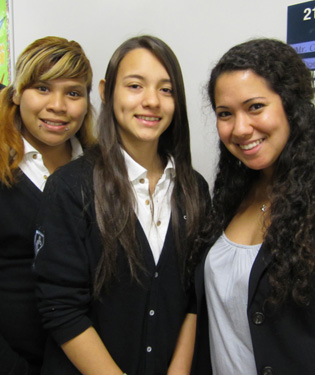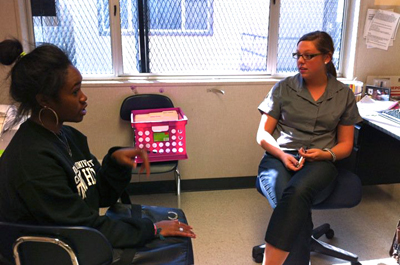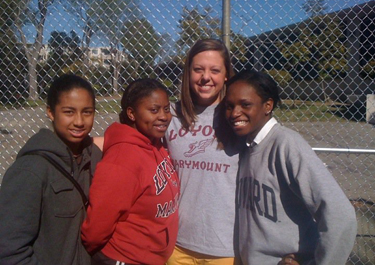 At 22 years old and standing just over five feet, Avery Seretan is sometimes mistaken for a student. She’s actually a ninth-grade special education teacher in Watts. And depending on the day, she’s also a mother, confidant, guardian and referee for her students.
At 22 years old and standing just over five feet, Avery Seretan is sometimes mistaken for a student. She’s actually a ninth-grade special education teacher in Watts. And depending on the day, she’s also a mother, confidant, guardian and referee for her students.
Today is a “good day” at the charter school College Ready Academy High School #11. As students yell out questions, Seretan patiently reminded them to raise their hand, and when they do, she answered their queries. Some of the questions were about the English lesson, but for the most part students wanted personal details about their teacher.
“Miss, are you married?”
“No, I’m not.”
“Miss, do you have a boyfriend yet?”
“Yes,” Seretan said, and after that admission, she quickly scolded her students to pay attention to their lessons before they could ask any more questions. Later, she laughed as she explained some of the more personal questions her students have asked.
“They are in ninth grade, so they know about sex and drugs and, in some ways, have a broader life experience than myself,” Seretan said. “But I still see them as my kids and when they ask those questions I’m like that’s totally inappropriate. I immediately change the subject.”
Teaching ninth graders at a charter school in Watts isn’t always funny questions and laughter. Each day, Seretan deals with the pressure of helping her students succeed in a neighborhood affected by gang violence and crime. She works as a special education teacher, helping special needs students with English and math.
Some students have learning disabilities, reading and writing at a second grade level. Others have behavioral disorders that have led to violence in the classroom.
“They all have different personalities and tick in different ways and you have to respond to them very differently,” Seretan said.
Working for a charter school in South Los Angeles isn’t what Avery imagined as her first job after college. A year ago, Seretan said her plan was to graduate, travel and eventually move to Washington to pursue a job in politics.
“I definitely don’t see myself teaching, but I always saw myself doing some type of community work to give back in some way,” Seretan said.
Born and raised in Seal Beach, Seretan was educated in private schools most of her life. She went to a private middle school and all-girls, Catholic high school before attending the private University of San Diego. She earned her bachelor’s degree in political science, but decided she wanted to give something of her time and self before pursuing her dreams in Washington, D.C.
As a senior, Seretan was recruited for the Teach for America program. Teach for America has a reputation as a competitive and extremely demanding program. It was a challenge Seretan couldn’t resist.
She applied and was accepted to teach in Los Angeles. Seretan said it is her biggest achievement so far.
“I’ll never forget that it was Nov. 10 and I got an email from [Teach for America] saying I was accepted and I was so excited,” she said.
With one semester of teaching under her belt, Seretan is confident in her teaching and her students. She said the first semester was difficult and things can only improve in the future.
She still plans to travel and live in Washington, but now they come second to the hopes she has for herself and her students while teaching.
“For me, I want to be content and happy with what I’m doing and then push these kids forward,” she said. “They have no options, they need to focus and get out of Watts. I want to get my kids out of Watts and have a better life.”
Until then, she says Washington can wait.









 Classroom T-12 at Lou Dantzler Preparatory High School in Los Angeles is hidden within an urban maze of chain link fences, Port-o-Potties and portable classroom sheds called bungalows. But inside the makeshift-learning hub, a focused group of 12th grade English students works diligently on their research paper rough drafts, as the inspirational Michael Jackson song “Man in the Mirror” fills the room.
Classroom T-12 at Lou Dantzler Preparatory High School in Los Angeles is hidden within an urban maze of chain link fences, Port-o-Potties and portable classroom sheds called bungalows. But inside the makeshift-learning hub, a focused group of 12th grade English students works diligently on their research paper rough drafts, as the inspirational Michael Jackson song “Man in the Mirror” fills the room.  “Right now, they see it as a demoralizing test that costs them money, and that they will get nothing out of,” said Miller. “That is the problem, this lack of confidence in what they can become and what they can achieve, and that is a battle I fight every day.”
“Right now, they see it as a demoralizing test that costs them money, and that they will get nothing out of,” said Miller. “That is the problem, this lack of confidence in what they can become and what they can achieve, and that is a battle I fight every day.”




